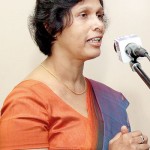News
Stroke rights consistent with human rights
Stroke rights are consistent with human rights is the simple fact that was reiterated when the Global Stroke Bill of Rights was launched in Colombo on Wednesday – World Stroke Day.

Dr. Udaya Ranawaka presents the Stroke Bill of Rights to Health Minister Maithripala Sirisena while Dr. Palitha Mahipala and Dr. Neelamani Rajapaksha Hewageegana look on Pix by Indika Handuwala & graphic by Nalin Balasuriya
The National Stroke Association of Sri Lanka (NSASL) presented the Stroke Bill of Rights not only in English but also in Sinhala and Tamil to Health Minister Maithripala Sirisena at a ceremony at the Health Education Bureau (HEB). The presentation by NSASL President and Consultant Neurologist Dr. Udaya Ranawaka came hot on the heels of the international launch in Turkey by the World Stroke Organization the previous week.
Explaining how the Stroke Bill of Rights (see graphic) came about, NSASL’s Immediate Past President and Consultant Neurologist, Dr. Padma Gunaratne said that it was developed by a group of stroke survivors, after which patients and care-givers from all over the world, from different cultures and countries, contributed to a survey. The Bill of Rights was finalised thereafter.
Although it is not a legal document, Dr. Gunaratne underscored that the Stroke Bill of Rights is consistent with basic human rights that are overseen by international law and urged “us all” to take on the

Dr. Padma Gunaratne explains the Stroke Bill of Rights to the media
responsibility of using it.
“The needs are consistent regardless of where people affected by stroke live,” she said, adding that the issues have been prioritised according to their importance by survivors and care-givers themselves. These issues cut across global borders, cultures, religions and communities.
Asking why attention should be paid to the rights of stroke patients and care-givers, she answered that many stroke patients are unable to access treatment, rehabilitation and support that would give them a greater chance of good recovery. “This is why the Stroke Bill of Rights helps to communicate with stroke care providers on what people affected by stroke think are the most important things in their recovery. It clearly identifies the aspects of care that are important to get the best possible outcomes.”
The Stroke Bill of Rights is aligned with the World Health Organisation’s Global Action Plan for the Prevention and Control of Non-Communicable Diseases (NCDs) 2013-2020 and the United Nations Resolutions on the Prevention and Control of NCDs issued in 2011 and 2014; and is consistent with the human rights approach, an equity-based approach, empowerment of people and communities and evidence-based strategies, it is learnt.
Dr. Gunaratne pointed out that in Sri Lanka, Minister Sirisena and the health authorities have been a tower of strength in taking the stroke message forward. Usually the biggest problem is getting the attention of policy-makers but the stroke cause has been supported fully by the authorities.
Reiterating that not only is stroke preventable but it is also treatable, NSASL President Dr. Ranawaka commended the Government for allocating funds in the Budget for the setting up of six more Stroke Care Units across the country. Currently there are only seven such units in Colombo, Kurunegala, Diyatalawa, Anuradhapura, Kalutara, Ragama and Sri Jayewardenepura Hospitals. He also urged the establishment of rehabilitation units within hospitals.
“An emergency approach, optimal supportive care, Stroke Unit care, thrombolysis — ‘clot buster’ treatment and rehabilitation are crucial, for early treatment minimises death and disability,” he stressed.
While the ‘burden’ of stroke worldwide is that every two seconds, someone suffers a stroke and every six seconds, someone dies of a stroke, Dr. Ranawaka said that it is the second commonest cause of death worldwide and causes 10% of all deaths. Eighty-five percent of stroke-related deaths are in developing countries and stroke is the commonest cause of adult disability worldwide.
Referring to Sri Lanka, he said that 10% of all in-hospital deaths are due to stroke and the prevalence of stroke in the country is among the highest in the world.
“Stroke is different to other diseases,” he said, adding that many patients do not recognise a stroke, do not seek treatment early and as such many patients die or become disabled.
In the early 2000s there was no word in Sinhala for stroke, said Dr. Ranawaka, adding that it was the NSASL which coined the word ‘agathaya’ whereas earlier only the symptom of paralysis or ‘anshabagaya’ was mentioned as the disease. While the World Stroke Organisation began celebrating World Stroke Day only recently, the NSASL which was set up in 2001 has been holding a National Stroke Day for a long time.
“Join us to fight stroke. We need you,” he urged, for stroke affects the entire family.
Among those present at the launch to show their commitment to battling stroke on all fronts – prevention, treatment and rehabilitation – were Health Services Director-General Dr. Palitha Mahipala, Health Services Deputy Director-General Dr. Sarath Amunugama, HEB Director Dr. Neelamani Rajapaskha Hewageegana, Consultant Neurologists Dr. Arjuna Fernando and Dr. Harsha Gunasekera and Consultant Rheumatologist Dr. Lalith Wijayaratne.

